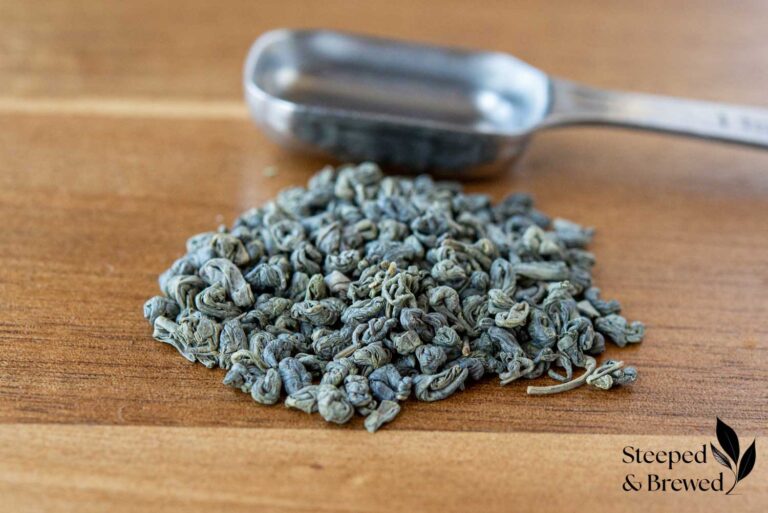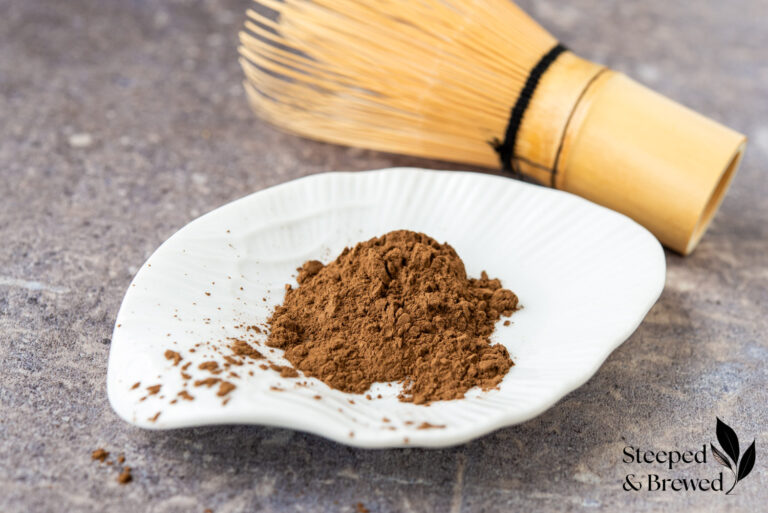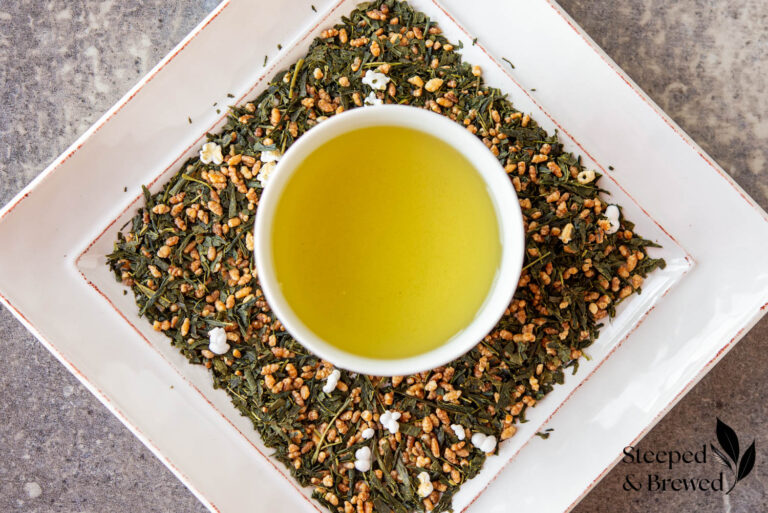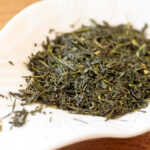This post may contain affiliate links. That means if you click on a link and make a purchase, I may make a small commission at no additional cost to you. Thank you for your support!
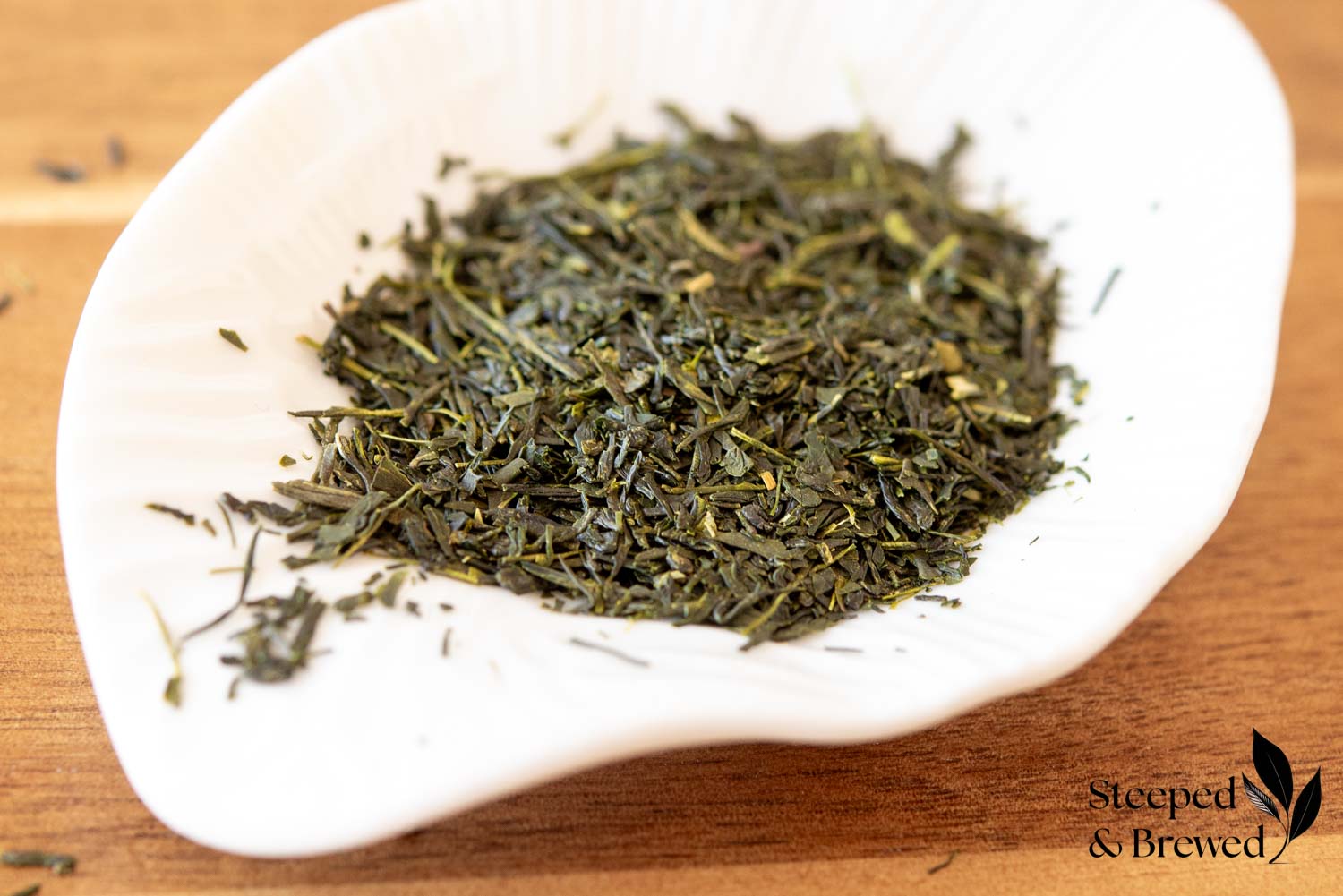
I’ve really come to love sencha green tea recently. I’m all about beverages that are rich and full of flavor, and sencha totally delivers with its full-bodied, vegetal umami goodness and just a hint of pleasant bitterness. There is so much to explore in the world of sencha tea, and this article only touches the surface with a general overview. Look out for more articles from Steeped & Brewed in the future, all about sencha green tea!
What is Sencha Green Tea?
What is sencha? Sencha green tea is like the cool, sophisticated member of the green tea family. Originating in Japan, the steamed and rolled leaves are a beautiful green color that looks almost like freshly cut grass. Once steeped, the leaves unfurl, revealing their full shape, and yield a lovely yellow-green hue with a complex flavor profile. It may feature sweet, occasionally fruity undertones, vegetal notes reminiscent of steamed spinach, and pleasant, subtle bitter tones that contribute to a refreshing briskness.
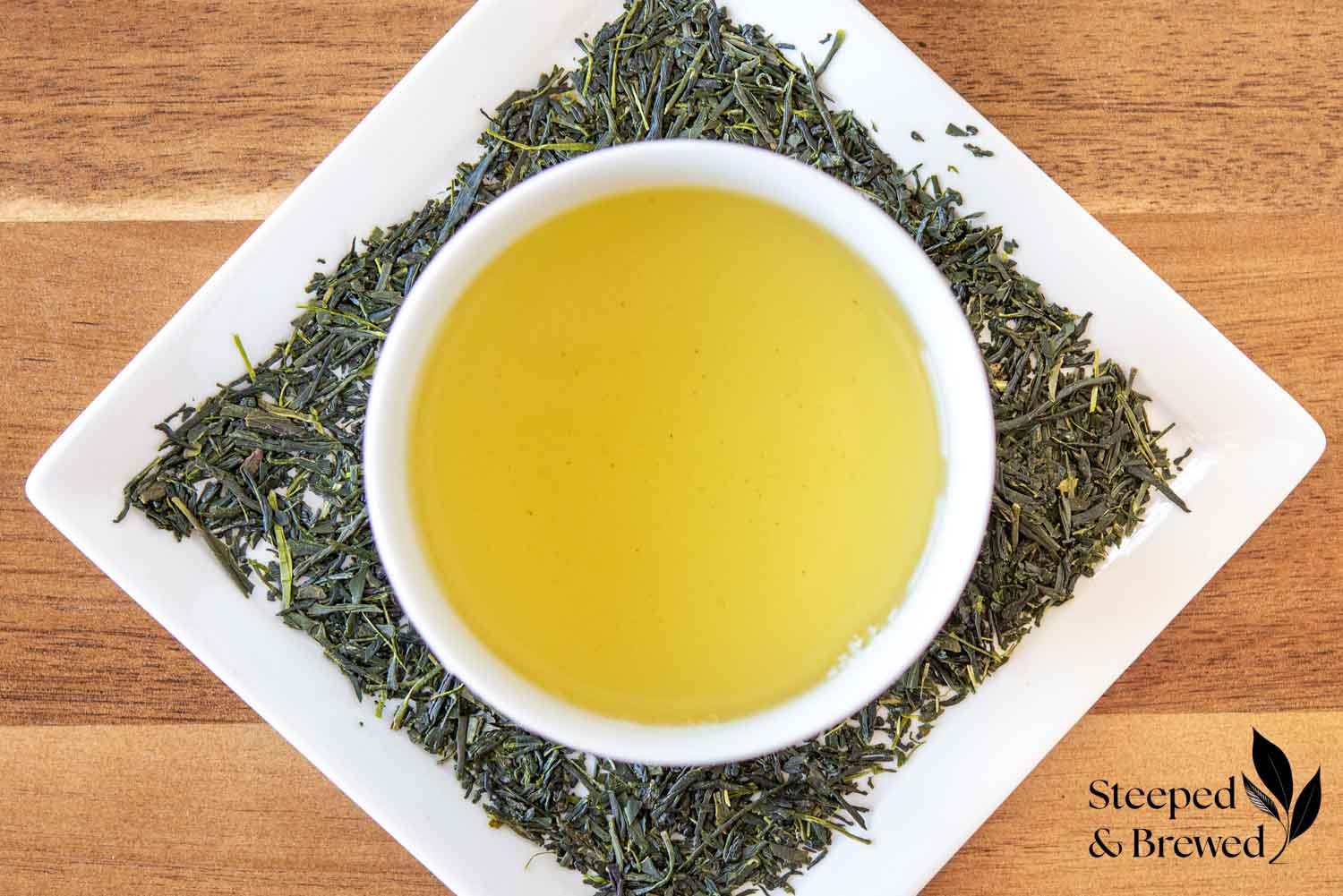
How is Sencha Green Tea Produced?
Sencha green tea is predominantly produced in Japan. Production begins with the careful harvesting of young tea leaves from the Camellia sinensis plant. Once picked, the leaves are quickly steamed to halt oxidation, preserving their vibrant green color and fresh, grassy flavor. This steaming process, which typically lasts about 1 minute depending on the style, is part of what sets sencha apart from other green teas that might be pan-fried or roasted. After steaming, the leaves are rolled into their characteristic needle-like shape. This rolling not only gives sencha its unique appearance but also helps break down the cell walls of the tea leaves, enhancing its flavor.
After rolling, the tea leaves are dried to reduce moisture content, ensuring they are shelf-stable and ready for brewing. The final product is a beautifully green, fragrant tea that, when brewed, delivers a complex, refreshing cup with a balance of sweetness, steamed veggie notes, and slight bitterness. The meticulous steps in sencha production—from steaming and rolling to drying—are what give this tea its distinctive, beloved character.
The Origins of Sencha Green Tea
Sencha tea has a rich history that dates back to the 17th century in Japan. Credit is given to Nagatani Soen, who in 1738, is said to have invented the method of steaming and rolling the tea leaves into their unique needle-like shape. Before this time, powdered green tea (think of your favorite cup of matcha) was the most common form of tea. Sencha offered a more casual, everyday alternative and quickly gained popularity among the Japanese people.
As sencha became more widespread, it also began to embody the Japanese aesthetic and appreciation for simplicity and natural beauty. The method of steaming and rolling the tea leaves was perfected over time, enhancing both its flavor and its appeal. Today, sencha remains the most popular type of tea in Japan, enjoyed daily by millions. It’s not just a beverage; it’s a part of Japanese culture and tradition, symbolizing harmony and mindfulness in every cup.
Are There Different Types of Sencha Green Tea?
Yes, indeed! There are many different types of sencha tea to explore, each with its unique characteristics influenced by factors such as the region where it is grown, the time of harvest, whether it is shaded or not, and specific processing methods. Here are just a few options to explore…
Asamushi Sencha is lightly steamed for a shorter duration, resulting in a tea with a delicate flavor and a light, clear green color. This type of sencha is ideal for those who appreciate a milder, more subtle taste.
On the other end of the spectrum, there is Fukamushi Sencha, which undergoes a longer steaming process. This extra steaming breaks down the leaves more, creating a tea with a deeper, more robust flavor and a darker green, almost opaque liquor. This type of sencha is perfect for those who enjoy a stronger, more intense green tea experience.
Then there’s Chumushi Sencha, which falls somewhere between Asamushi and Fukamushi in terms of steaming time. It offers a balanced flavor profile, combining the lightness of Asamushi with the richness of Fukamushi.
Additionally, Kabusecha is a shaded type of sencha where the tea plants are covered for a short period before harvesting, resulting in a tea with a sweeter, more umami-rich flavor. Exploring these different types of sencha allows tea enthusiasts to appreciate the diverse and nuanced world of Japanese green tea.
My Favorite Everyday Sencha!

Harney & Sons Japanese Sencha Green tea, Loose leaf 4 ounce
Buy Now →How to Brew Sencha Green Tea
The basic formula to brew a balanced cup of sencha green tea is 4 grams of tea (about 1 to 1 1/2 teaspoons) for every 8 ounces of water at around 160°F (71°C), steeped for 1 to 2 minutes. Adjust the volume of tea and steeping time according to your taste. Less tea leaves and less time will brew a more delicate cup. More leaves for longer will yield a stronger cup. But don’t overdo it! Sencha can become overly bitter if steeped for too long.
Keep in mind, these are just guidelines. Brewing the perfect cup of tea is all about your personal taste.
Frequently Asked Questions
Can sencha be resteeped?
Yes! Use the same temperature water – about 160°F (71°C) – but steep for a slightly shorter time – about 30 seconds to 1 minute. The reason for the shorter steeping time is that the leaves have already unfurled, so they only need a short dip in hot water to release additional flavor.
How can I identify high-quality sencha green tea?
Identifying good quality sencha green tea involves paying attention to several key characteristics. First, look at the leaves themselves. High-quality sencha leaves should be vibrant, dark green, and have a glossy sheen. They are typically needle-shaped and uniform in size, indicating careful processing. If the leaves appear dull or overly broken, the tea might not be of the best quality.
When brewed, good sencha produces a bright, yellow-green liquor. The aroma should be fresh and grassy, evoking the scent of freshly cut grass or steamed greens. Taste is another crucial factor; high-quality sencha has a balanced flavor profile with sweet, nutty, and steamed veggie notes, accompanied by a pleasant, mild bitterness. There should be no astringency or harshness in a good cup of sencha. Lastly, the leaves should unfurl fully when steeped, releasing their flavor evenly and consistently. By paying attention to these visual, aromatic, and taste cues, you can confidently identify high-quality sencha green tea.
How does the season of harvest influence the taste of sencha green tea?
Sencha harvested in the early spring, known as “first flush” or “Shincha,” is highly prized for its delicate and fresh flavor. These leaves, picked from late April to early May, benefit from the cooler weather and slower growth, which concentrates the tea’s sweet, umami-rich notes. First-flush sencha often has a vibrant green color and a light, refreshing taste with minimal bitterness. Most quality sencha on the market come from this spring harvest.
As the seasons progress, the flavor profile of sencha changes. Second flush or “Nibancha” is harvested in mid-summer. The leaves grow more quickly during this time due to the warmer weather, resulting in a bolder, slightly more astringent flavor compared to the first flush. These leaves are often used in bottled tea or tea bags.
Third flush or “Sanbancha”, harvested later in the summer, yields leaves that are often considered lower quality and may be used for inexpensive tea bags.
How do I properly store sencha green tea?
Properly storing sencha green tea is essential to maintain its freshness and flavor. The key is to protect it from light, air, moisture, and heat. Start by keeping your sencha in an airtight container, preferably one that is opaque to block out light. Metal containers with tight-fitting lids work well. If your tea comes in a resealable bag, you can store the bag itself in an additional airtight container for extra protection.
Next, find a cool, dark place to store your tea. A pantry or cupboard away from the stove or any heat source is ideal.
Lastly, try to consume your sencha within a few months of purchase for the best flavor. Over time, even well-stored tea can lose its vibrancy and freshness.
Want to Learn More?
Check out this great video all about sencha green tea from Nio Teas…


